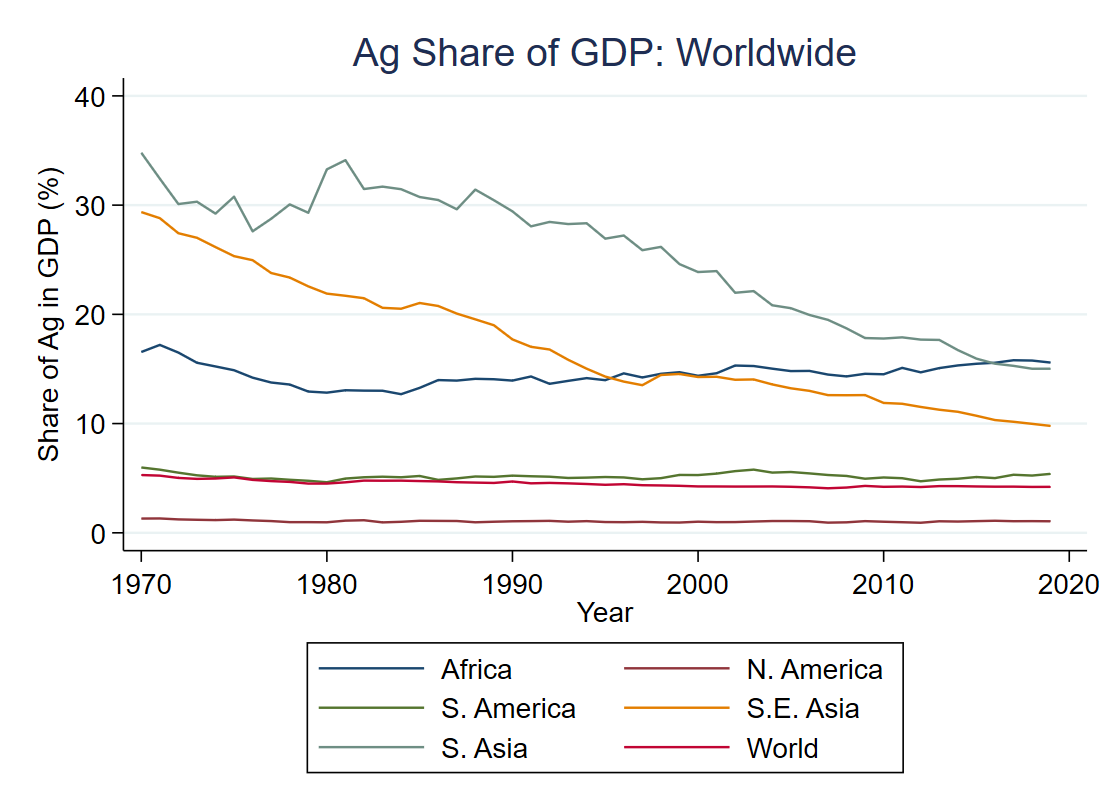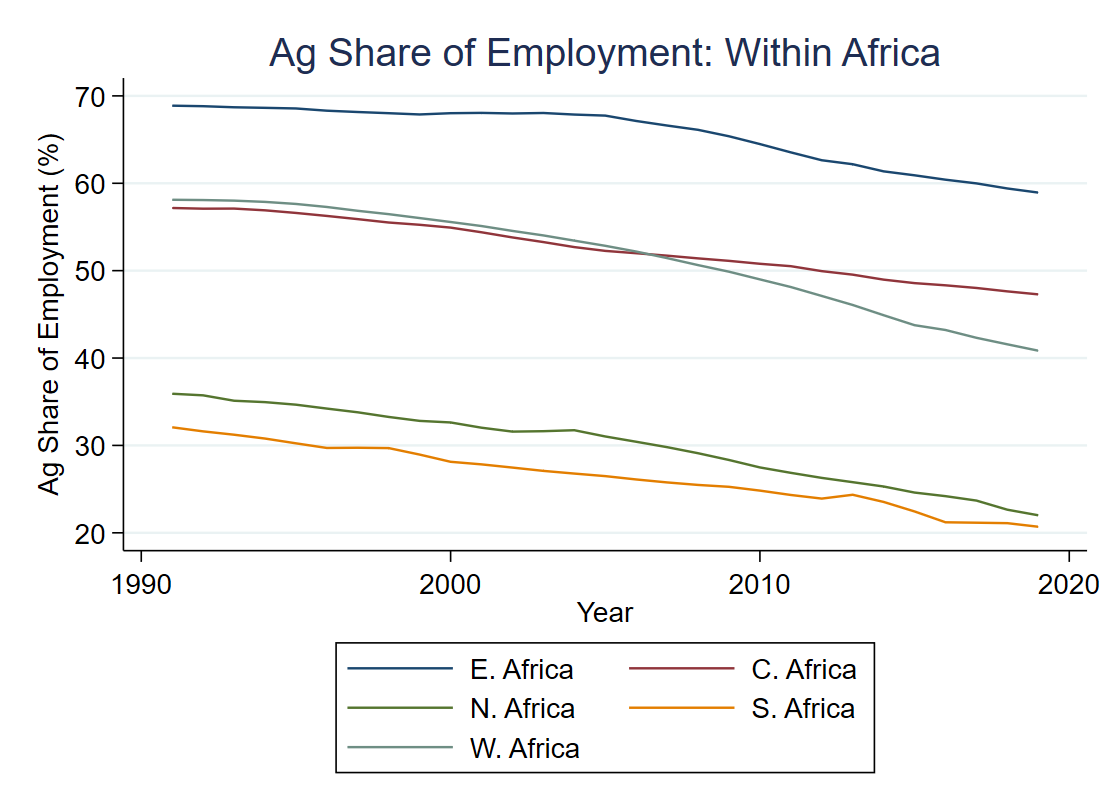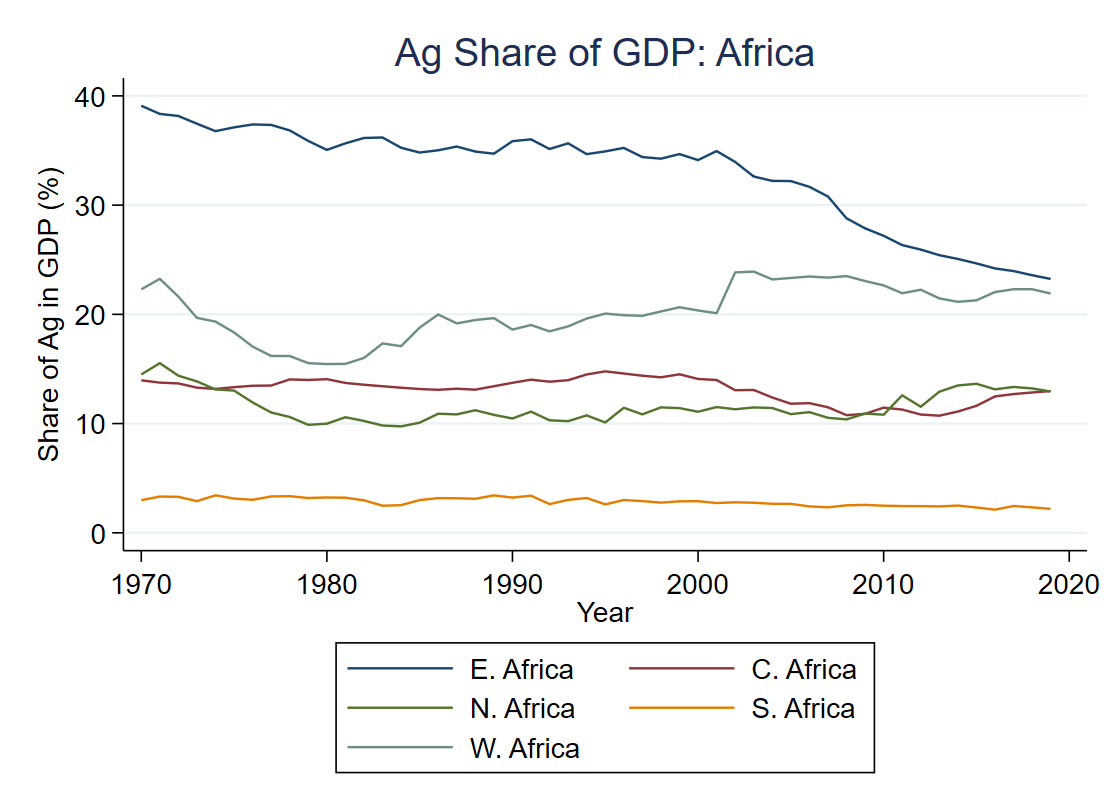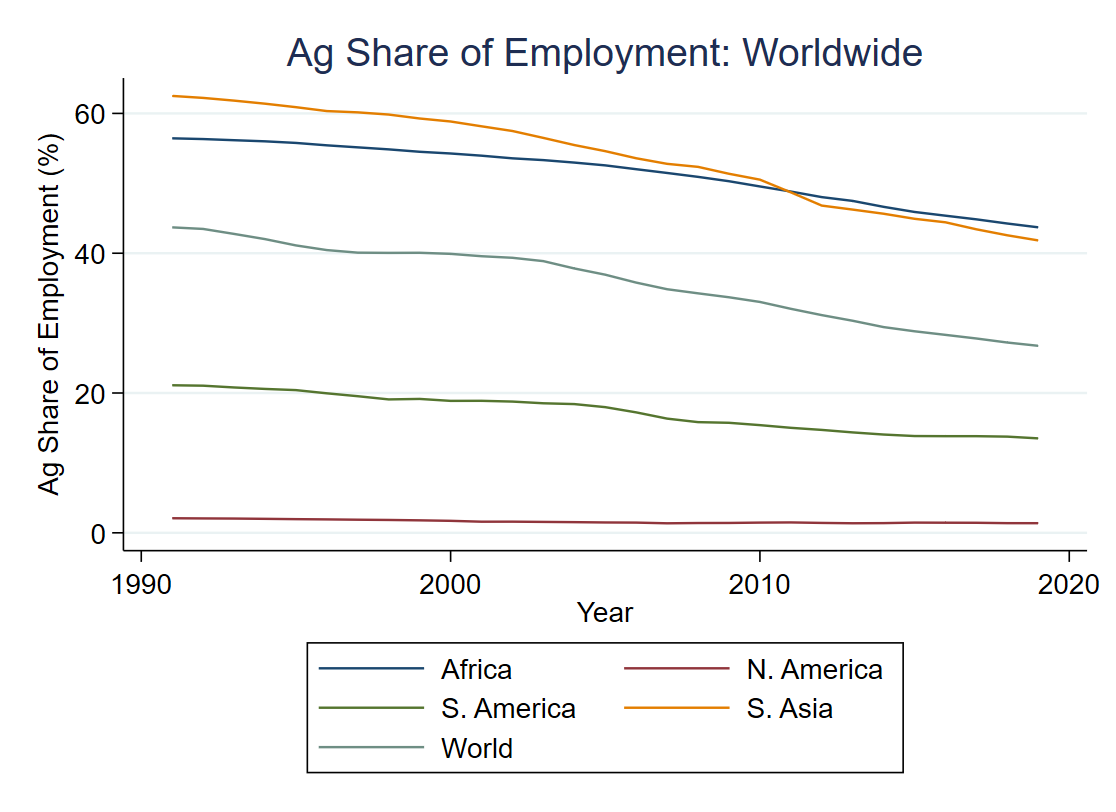
Economic development typically involves a structural transformation in which a dominantly agrarian economy moves towards being more manufacturing and services-based (Timmer 2009). However, across Africa, many countries’ economies still rely especially heavily on agriculture compared with the rest of the world, in terms of both output and jobs. The high shares of agriculture in GDP and employment in Africa largely reflect the low level of GDP per capita on the continent (Herrendorf et. al. 2014). Figure 1 shows that agriculture is almost 20% of GDP in Africa[1], compared with a world average of about 5%. Moreover, the agricultural share of GDP for the African region has remained stable over the last 50 years, whereas the share for other regions that started high in 1970 – South East Asia and South Asia – has fallen dramatically. Panel B shows how agricultural shares of employment have declined across different regions of the world over the last 30 years. Africa now has the highest share of employment in agriculture at about 50%, while the world average of employment in agriculture is closer to 30%.
Regions within Africa exhibit considerable variation in shares of GDP and employment in agriculture, the highest being East and West Africa and the lowest Southern Africa. Panel C of Figure 1 shows that agriculture’s share of GDP has been falling in East Africa, where it has historically been highest, but not in other regions. Panel D shows the wide disparity in the share of the workforce in agriculture across regions of Africa, although the share is dropping everywhere.
Figure 1: Agriculture’s contribution to GDP and jobs
Panel A: Share of agricultural GDP across regions of the world, 1970-2019

Panel B: Share of agricultural employment across regions of the world, 1991-2019

Panel C: Share of agricultural GDP across regions in Africa, 1970-2019

Panel D: Share of agricultural employment across regions in Africa, 1991-2019

A first step towards structural transformation happens as the agricultural sector evolves from smallholder farmers growing mainly food crops (cereals) for self-consumption to larger-scale farmers growing food crops largely for sale. At present, about 80% of African farmers are smallholders with under two hectares of land, who together account for 40% of cultivated area (Lowder et al. 2016). However, farm sizes seem to have been on the rise in some African countries (Jayne et al. 2016). Increasing agricultural productivity through improved technology is key to this process of agricultural and structural transformation (Bustos et al. 2016, Bustos et al. 2020, Dercon and Gollin 2014, Gollin et al. 2021, Timmer 2009). Examples of specific technological changes that may form part of this process include the mechanisation of farm activities (such as land preparation and transportation), and the use of labour-saving agrochemicals like pesticide and herbicide (Foster and Rosenzweig 2022). There are clearly documented causal links from increased agricultural productivity to reduced poverty (for a good review, see de Janvry and Sadoulet 2010) and improved child nutrition (for example, Glennerster and Suri 2018).
Many historical examples demonstrate African farmers’ flexibility and openness to innovation: centuries-old examples like the introduction of maize, cassava, and sweet potatoes to Africa as part of the Columbian exchange; decades-old examples, like the transformation of the economy of Ghana or Cote d’Ivoire with the introduction of cocoa (Hill 1963, Chauveau and Leonard 1996); and more recent examples like the emergence of commercial flowers for export from Kenya and Ethiopia - all of which demonstrate a willingness to adapt to farming new crops. There has been some innovation in terms of input intensification on existing cropland, but still, the intensity of fertiliser use, herbicides, mechanisation, etc. lags far behind other regions of the world. Across the world, value-added per worker in agriculture is lower than it is in the rest of the economy, but the gap is largest in Africa (Gollin et al. 2014).
In this VoxDevLit, we start with some background about agricultural productivity and technology adoption in Africa, highlighting how it has lagged. We then discuss what may explain these lags, and what we know about each of these explanations. We discuss the importance of heterogeneity, along a variety of dimensions, in understanding the patterns of agricultural productivity and technology use in Africa. Public and private investment in new agricultural technology in Africa has been extremely limited, and no large set of profitable technologies waits on the shelf to be adopted by Africa’s farmers. But there are viable directions for policy, and an important set of unanswered research questions.
References
Bustos, P, B Caprettini and J Ponticelli (2016), "Agricultural Productivity and Structural Transformation: Evidence from Brazil", American Economic Review, 106(6): 1320-65.
Bustos, P, G Garber and J Ponticelli (2020), "Capital Accumulation and Structural Transformation", The Quarterly Journal of Economics, 135(2): 1037-1094.
Chauveau, J P and E Léonard (1996), "Côte d’Ivoire’s Pioneer Fronts: Historical and Political Determinants of the Spread of Cocoa Cultivation", in Clarence-Smith, W G (eds) Cocoa Pioneer Fronts since 1800, Palgrave Macmillan, London.
de Janvry, A and E Sadoulet (2010), "Agricultural growth and poverty reduction: Additional evidence", The World Bank Research Observer, 25(1): 1-20.
Dercon, S and D Gollin (2014), "Agriculture in African development: theories and strategies", Annual Review of Resource Economics, 6(1): 471-492.
Foster, A D and M R Rosenzweig (2022), "Are there too many farms in the world? Labor-market transaction costs, machine capacities and optimal farm size", Journal of Political Economy, 130(3): 636-680.
Glennerster, R and T Suri (2018), "Agricultural Technology and Nutrition in Sierra Leone", Unpublished.
Gollin, D, C W Hansen and A Wingender (2021), "Two Blades of Grass: The Impact of the Green Revolution", Forthcoming, Journal of Political Economy.
Gollin, D, D Lagakos and M E Waugh (2014), "Agricultural productivity differences across countries", American Economic Review, 104(5): 165-70.
Herrendorf, B, R Rogerson and A Valentinyi (2014), "Growth and Structural Transformation", Handbook of Economic Growth, Chapter 6, Volume 2: 855-941, Elsevier.
Hill, P (1963), Migrant Cocoa-Farmers of Southern Ghana: A Study in Rural Capitalism, London: Cambridge University Press.
Jayne, T S, J Chamberlin, L Traub, N Sitko, M Muyanga, F K Yeboah, W Anseeuw (2016), "Africa's changing farm size distribution patterns: the rise of medium‐scale farms", Agricultural Economics, 47(S1): 197-214.
Lowder, S K, J Skoet and T Raney (2016), "The number, size, and distribution of farms, smallholder farms, and family farms worldwide", World Development, 87: 16-29.
Timmer, C P (2009), A World without Agriculture: The Structural Transformation in Historical Perspective, Henry Wendt Lecture, Washington: American Enterprise Institute.
United Nations, Food and Agriculture Organization (FAOSTAT), https://www.fao.org/faostat/en/#data.
The World Bank, World Development Indicators (WDI), http://wdi.worldbank.org/table/2.3.
Contact VoxDev
If you have questions, feedback, or would like more information about this article, please feel free to reach out to the VoxDev team. We’re here to help with any inquiries and to provide further insights on our research and content.




